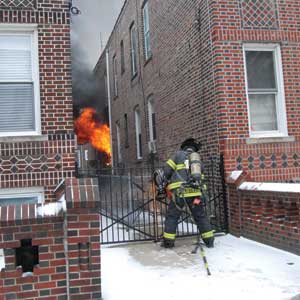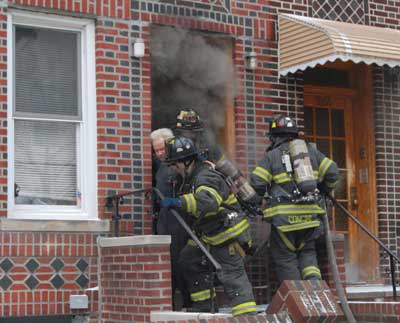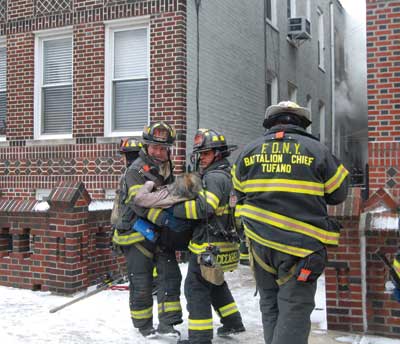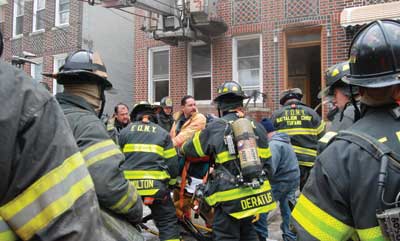By Michael M. Dugan
The fire service is undergoing a change in thinking right now. We are hearing about flow paths, ventilation controls, and transitional attack. The fire service is in a period of change and tactical reevaluation. We are hearing about safety and ventilation-factors that impact our operations. The issue seems to be that sometimes we forget our core values. “To Protect Life and Property” is what we swore to do when we became firefighters and fire officers.
 |
| (1) The fire is in the two-story ordinary construction structure. The fire is self-venting out of the first-floor window. The firefighter is getting ready to take the front gate to access the rear yard. (Photos by Allen Epstein.) |
These photos from a fire in Brooklyn, New York, show a fire that is self-venting and showing out a window on the exposure 2 or B side of the dwelling. The building is a two-story semiattached private dwelling with one apartment per floor. A lot of these types of structures have been broken up and now have multiple living units on both floors and possibly the basement. Responding units have to do a complete size-up and look for doorbells and mailboxes that indicate additional dwelling units. Also, information from previous responses and inspections hopefully was added to the department’s database and was transmitted to responding units. At this fire, personnel undertook a frontal attack based on size-up and situational awareness of the first-in officers. They observed the fire venting out the window and knew they had possible victims. The plan was to place a hoseline between the fire and the victims.
 |
| (2) The fire is self-venting and exposing the second floor of this building to the possible spread of fire. |
As we see in the photos, this fire is venting out of the windows, and the front door is open. This is not changing the flow of the fire dramatically. The fire might grow in intensity with the introduction of more oxygen, but the engine company has a straightforward hose stretch. The truck company needs the door open to allow for removal of the civilian and also for the engine to pass with the line.
 |
| (3) A civilian is being removed through the front door, and the door is open. This flow path will allow additional oxygen to feed the fire. |
We must understand what the modern fire research is telling us and how to use that information. This fire is self-venting and showing from a side window toward the rear. It would take more time to “hit it hard from the yard” than it would to get the line into place. Yes, we could reset the fire, which means cooling the hot gas and fire from the exterior, therefore delaying or slowing the fire progression and buying more time until flashover, but at what cost? There are rescues to be made and lives to be saved. Which is faster and which is safer? What would you want done if your loved one were trapped?
 |
| (4) The officer has to remove his face piece to communicate with the fire victim to try to determine the location of a reported additional victim. |
The engine and the truck must coordinate the attack and have a plan that includes their both having the same strategy and tactics in place. If the engine were to stretch to the side yard for a quick knockdown while the truck members were inside making a rescue, the engine might injure the truck members and the rescued civilians. The science that is now a part of our attack planning and deployment of units is a tactical decision. The new term is “transitional attack,” which is resetting the fire from the exterior. That means applying water from the exterior. If applying water from the exterior is going to be your only option, then you have missed the lessons and intent of the studies. The idea is to do what is quickest to get water on the fire and to limit the exposure of firefighters and civilians to the products of combustion. Like all other tactics in the fire service, this is a means to a goal, which is, again, to protect life and property. Therefore, we must determine at every fire what tactics we are going to use. They change at every fire, as they should. If you think that one size fits all or one tactical plan fits all fires, you are missing the point.
 |
| (5) The second victim was located and removed from the fire area after an aggressive interior attack and search. |
It is the duty of the chiefs, the officers, and the firefighters of every department to become proficient at what we do. It does not matter if you are a career, a paid on-call, or a volunteer firefighter; you are duty bound to try to get better once you take your oath of office. You get better by drilling, training, reading, listening, and learning about what you do. What we have chosen to do is dangerous, and we do it anyway. If you only want one option, then the fire service is not for you.
 |
| (6) The second victim is turned over to emergency medical service personnel. The rescue is not complete until the victim is receiving medical care. |
We have many ways of attacking fires. They vary by department and region, but the bottom line is that we are doing our best with what we have to make the public and the firefights safe. The science and the studies are good tools, but it’s the operator of the tools that makes all the difference.
MICHAEL M. DUGAN is a 27-year veteran of the Fire Department of New York, where he served as captain of Ladder Company 123 before retiring in 2012. As a lieutenant, he served in Ladder Company 42 and was a firefighter in Ladder Company 43. He has been involved with the fire service for 39 years.
Additional Links
Rapid Fire Spread at Private Dwelling Fires
High-Target Areas for the Residential Primary Search
Fire Engineering Archives

